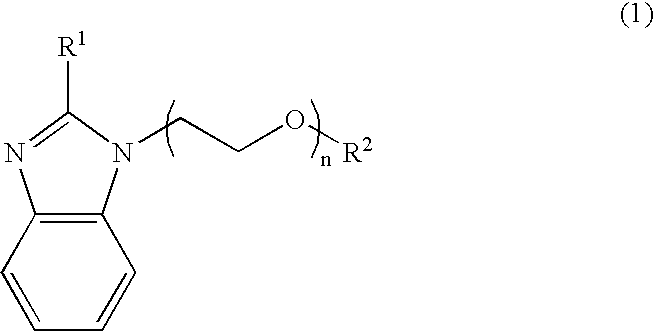Nitrogen-containing organic compound, resist composition and patterning process
a technology of organic compound and resist, which is applied in the direction of photosensitive materials, instruments, photomechanical equipment, etc., can solve the problems of difficult control of the dimension of prior-art positive-working chemically amplified resist in the lithographic process, reducing the final dimension of the pattern line, and minimizing the roughness of the sidewall, so as to optimize the resist characteristics including the pattern profile, the effect of high resolution
- Summary
- Abstract
- Description
- Claims
- Application Information
AI Technical Summary
Benefits of technology
Problems solved by technology
Method used
Image
Examples
example
[0234]Examples of the invention are given below by way of illustration and not by way of limitation.
synthesis examples
[0235]Nitrogen-containing organic compounds within the scope of the invention were synthesized by the method described below.
synthesis example 1
Synthesis of 1-(2-methoxyethyl)-1H-benzimidazole (Amine 1)
[0236]
[0237]In a nitrogen atmosphere, a mixture of 118 g of benzimidazole, 94.5 g of 2-chloroethyl methyl ether, 138 g of potassium carbonate, and 400 g of N,N-dimethylformamide was heated and stirred at 100° C. for 20 hours. The reaction mixture was subjected to conventional aqueous work-up and distillation under reduced pressure for purification, to give 154 g of 1-(2-methoxyethyl)-1H-benzimidazole (boiling point 125° C. / 33 Pa, yield 87%).
[0238]IR (thin film): ν=3085, 3054, 2983, 2929, 2890, 2831, 1616, 1496, 1457, 1361, 1332, 1288, 1276, 1251, 1214, 1199, 1180, 1151, 1118, 1066, 1014, 968, 931, 887, 835, 767, 744, 705, 632 cm−1
[0239]1H-NMR (600 MHz in CDCl3): δ=3.29 (3H, s), 3.69 (2H, t, J=5.2 Hz), 4.29 (2H, t, J=5.2 Hz), 7.27 (1H, dt, J=1.4, 7.2 Hz), 7.29 (1H, dt, J=1.7, 7.2 Hz), 7.38 (1H, m), 7.80 (1H, m), 7.95 (1H, br. s)
PUM
| Property | Measurement | Unit |
|---|---|---|
| wavelength | aaaaa | aaaaa |
| temperature | aaaaa | aaaaa |
| reaction time | aaaaa | aaaaa |
Abstract
Description
Claims
Application Information
 Login to View More
Login to View More - R&D
- Intellectual Property
- Life Sciences
- Materials
- Tech Scout
- Unparalleled Data Quality
- Higher Quality Content
- 60% Fewer Hallucinations
Browse by: Latest US Patents, China's latest patents, Technical Efficacy Thesaurus, Application Domain, Technology Topic, Popular Technical Reports.
© 2025 PatSnap. All rights reserved.Legal|Privacy policy|Modern Slavery Act Transparency Statement|Sitemap|About US| Contact US: help@patsnap.com



